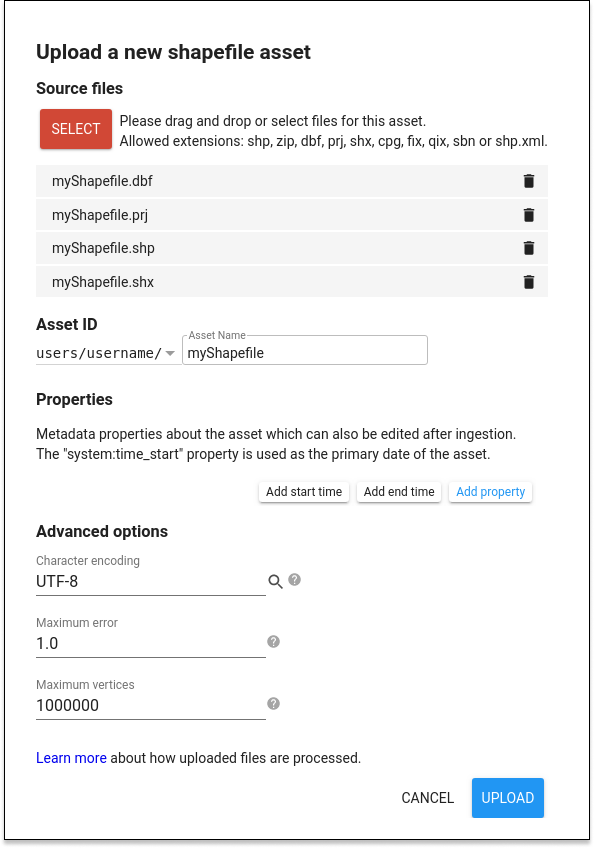Can You Mass Upload On Google Earth
Uploading tabular array avails
Y'all can use the Asset Managing director or command line interface (CLI) to upload datasets in the Shapefile or CSV format. (See Importing Raster Data for details on importing rasters using the Code Editor or CLI.) Your uploaded assets are initially private, but can be shared as described in the Sharing Avails Section.
Upload a Shapefile
To upload a Shapefile from the Code Editor, click the  button, then select Shape files under the Tabular array Upload section. An upload dialog similar to Figure 1 will be presented. Click the SELECT button and navigate to a Shapefile or Zip archive containing a Shapefile on your local file system. When selecting a .shp file, exist sure to select the related .dbf, .shx and .prj files. Earth Engine will default to WGS84 (longitude, latitude) coordinates if a .prj file is not provided. If you lot are uploading a Zippo annal, make sure it contains only one Shapefile (set of .shp, .dbf, .shx, .prj, etc.) and no duplicate filenames. Brand sure filenames do not include additional periods or dots. (Filenames will include a single period earlier the extension.)
button, then select Shape files under the Tabular array Upload section. An upload dialog similar to Figure 1 will be presented. Click the SELECT button and navigate to a Shapefile or Zip archive containing a Shapefile on your local file system. When selecting a .shp file, exist sure to select the related .dbf, .shx and .prj files. Earth Engine will default to WGS84 (longitude, latitude) coordinates if a .prj file is not provided. If you lot are uploading a Zippo annal, make sure it contains only one Shapefile (set of .shp, .dbf, .shx, .prj, etc.) and no duplicate filenames. Brand sure filenames do not include additional periods or dots. (Filenames will include a single period earlier the extension.)
Give the table an appropriate asset ID (which doesn't already be) in your user folder. Click UPLOAD to get-go the upload.

Upload a CSV file
To upload a CSV from the Lawmaking Editor, activate the Assets tab, and so click the  button and select CSV file under the Tabular array Upload section. An upload dialog like to Figure 2 will be presented. Click the SELECT push and navigate to a .csv file on your local file system. Give the tabular array a unique, relevant nugget ID proper noun. Click OK to start the upload.
button and select CSV file under the Tabular array Upload section. An upload dialog like to Figure 2 will be presented. Click the SELECT push and navigate to a .csv file on your local file system. Give the tabular array a unique, relevant nugget ID proper noun. Click OK to start the upload.

The CSV file should incorporate a row for each feature and as many columns every bit there are properties or variables for the feature gear up. If features are geospatial, they must have a geolocation defined by either a geometry string (GeoJSON, WKT) or 10 and y position properties. If the CSV file is an export from a GIS or geospatial data tool such every bit GDAL/OGR, a properly formatted and named geometry column should already exist. Alternatively, two columns for x and y coordinates representing indicate locations can be divers in a spreadsheet application and exported equally CSV format along with any other variables.
In the Advanced options section of the upload dialog, view and alter default settings. Get information about each parameter past hovering your cursor over the question mark symbol following parameter names.
Earth Engine will endeavor to detect a primary geometry column and assumes the information projection is WGS84 unless otherwise specified. The geodesic state of the geometries are determined by the default border interpretation of the given projection (e.thousand. WGS84 uses geodesic geometries), but this tin can be overridden in the Advanced settings carte. If the geometry of your data are points divers past x and y columns, be certain to proper noun the respective columns "longitude" and "latitude" or specify the x and y column names nether Advanced settings.
Tracking upload progress
Later on starting a table upload, an 'Asset ingestion' chore is added to the Task Manager, found under the Tasks tab at the correct side of the Lawmaking Editor. Check the upload status past clicking on the ? icon that appears when hovering over the chore. To cancel an upload, click on the spinning icon  side by side to the task. Once the ingestion is consummate, the chore cell will plow blue and the asset volition appear in your user folder under the Assets tab with a icon.
side by side to the task. Once the ingestion is consummate, the chore cell will plow blue and the asset volition appear in your user folder under the Assets tab with a icon.
Loading a tabular array asset to your script
To create a FeatureCollection in your script from a tabular array asset, import information technology as described on the Managing Assets page.
Can You Mass Upload On Google Earth,
Source: https://developers.google.com/earth-engine/guides/table_upload
Posted by: julianmosurlow.blogspot.com


0 Response to "Can You Mass Upload On Google Earth"
Post a Comment